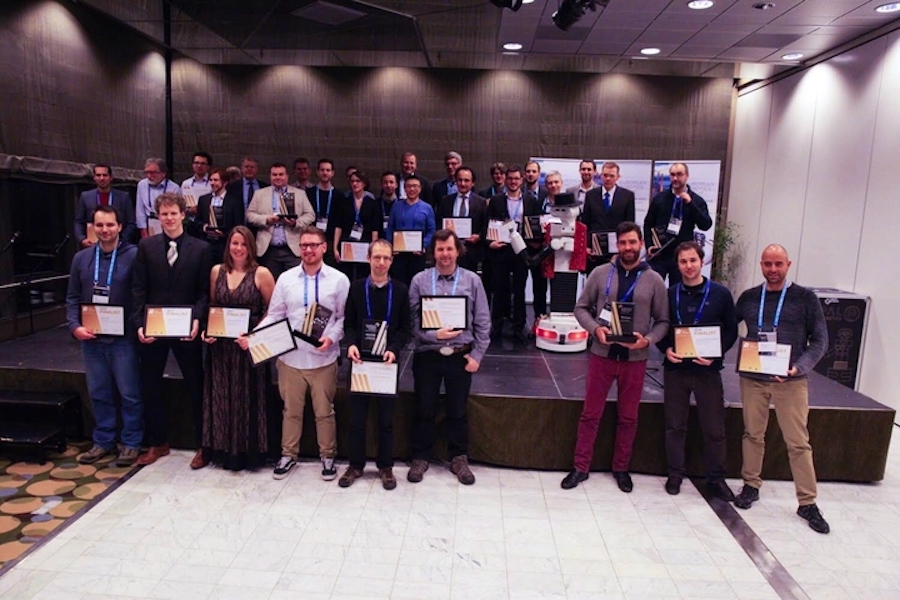
The European Robotics Forum 2018 (ERF2018) in Tampere brought together over 900 attendees from robotics academia and industry. To bridge the two, euRobotics hosted the Georges Giralt PhD Award 2017 & 2018 and the TechTransfer Award 2018, during a Gala Dinner event on 14 March, in Tampere, Finland.
The aim of the euRobotics Technology Transfer Award (now in its 15th year) is to showcase the impact of robotics research and to raise the profile of technology transfer between science and industry. Outstanding innovations in robot technology and automation that result from cooperative efforts between research and industry are eligible for the prize.
The First prize went to Germany’s Roboception: rc_visard – 3D perception & manipulation for robots made easy team, composed of Michael Suppa, and Heiko Hirschmueller from Roboception GmbH, and Alin Albu-Schaeffer from the Institute of Robotics and German Aerospace Center (DLR).
“This award is a recognition of our institute’s continued efforts of supporting the go-to-market of technologies developed at our institute or – as in this case – derived thereof,” said Prof. Albu-Schaeffer. Dr. Suppa added that “since spinning Roboception off the DLR in 2015, a significant amount of thought, hard work and – first and foremost – unfailing commitment of our team have gone into bringing this technology from a research state to a market-ready product. And we are very proud to see these efforts recognized by the jury, and rewarded with this prestigious award.” The rc_visard is already in operational use in a number of customer projects across a variety of robotic domains. Prof. Albu-Schaeffer, an enthused rc_visard user at his DLR Institute himself, is convinced that “this product is one that will shape the future of robotics, thanks to its unique versatility.”
Watch the an interview with rc_visard filmed at Hannover Messe
The Second prize went to Germany, to the project Mobile Agricultural Robot Swarms (MARS), created by a team made up of Timo Blender and Christian Schlegel, from Hochschule Ulm, and Benno Pichlmaier from AGCO GmbH. The MARS experiment aims at the development of small and stream-lined mobile agricultural robot units to fuel a paradigm shift in farming practices.
The Third prize went to Smart Robots from Italy, a team made up of Paolo Rocco and Andrea Maria Zanchettin, from Politecnico di Milano, and Roberto Rossi, from Smart Robots s.r.l., Italy. Smart robots provides advanced perception and intelligent capabilities to robots, enabling new disruptive forms of collaboration with human beings.
The Finalist was the In situ Fabricator (IF), an autonomous construction robot from Switzerland, with a team made up of Kathrin Dörfler from Gramazio Kohler Research, ETH Zurich, NCCR Digital Fabrication, Markus Giftthaler and Timothy Sandy from Agile & Dexterous Robotics Lab, ETH Zurich, NCCR Digital Fabrication.

The members of jury of the TechTransfer Award were: Susanne Bieller (Eunited Robotics), Rainer Bischoff (KUKA), Georg von Wichert (Siemens), Herman Bruyninckx (KU Leuven), Martin Haegele (Fraunhofer IPA). The euRobotics TechTransfer Award 2018 is funded by the EU’s Horizon 2020 Programme.
The Georges Giralt PhD Award showcased the best PhD theses defended during 2017 and 2018 in European universities from all areas of robotics
The 2017 edition saw 41 submissions from 11 countries. The jury composed of 26 academics from 16 European countries awarded:
Winner: Johannes Englsberger, Technical University of Munich, Germany – Combining reduced dynamics models and whole-body control for agile humanoid locomotion
Finalists:
- Christian Forster, University of Zurich, Switzerland – Visual Inertial Odometry and Active Dense Reconstruction for Mobile Robots
- Stefan Groothuis, University of Twente, the Netherlands – On the Modeling, Design, and Control of Compliant Robotic Manipulators
- Meng Guo, KTH Royal Institute of Technology, Sweden – Hybrid Control of Multi-robot Systems under Complex Temporal Tasks
- Nanda van der Stap, University of Twente, the Netherlands – Image-based endoscope navigation and clinical applications

The 2018 edition saw 27 submissions from 11 countries. The jury composed of 26 academics from 16 European countries awarded:
Winners:
- Frank Bonnet, École polytechnique fédérale de Lausanne (EPFL), Switzerland – Shoaling with fish: using miniature robotic agents to close the interaction loop with groups of zebrafish Danior rerio
- Daniel Leidner, University of Bremen, Germany – Cognitive Reasoning for Compliant Robot Manipulation
Finalists:
- Adrià Colomé Figueras, University Politècnica de Catalunya, Spain – Bimanual Robot Skills: MP Encoding and Dimensionality Reduction
- Đula Nađ, University of Zagreb, Croatia – Guidance and control of autonomous underwater agents with acoustically aided navigation
- Angel Santamaria-Navarro, University Politècnica de Catalunya, Spain – Visual Guidance of Unmanned Aerial Manipulators

The Ceremony saw the handing of the European Robotics League (ERL) Awards: ERL Industrial Robots and ERL Service Robots, and ERL Emergency Robots. Points are awarded by attending local and major tournaments, not a central event, with three main objectives: strengthening the European robotics industry, pushing innovative autonomous systems for emergency response, and addressing societal challenges of aging populations in Europe. The European Robotics League is funded by the EU’s Horizon 2020 Programme.
Read the ERL Awards press release: European Robotics League winners revealed in Tampere, Finland (Season 2017/18)


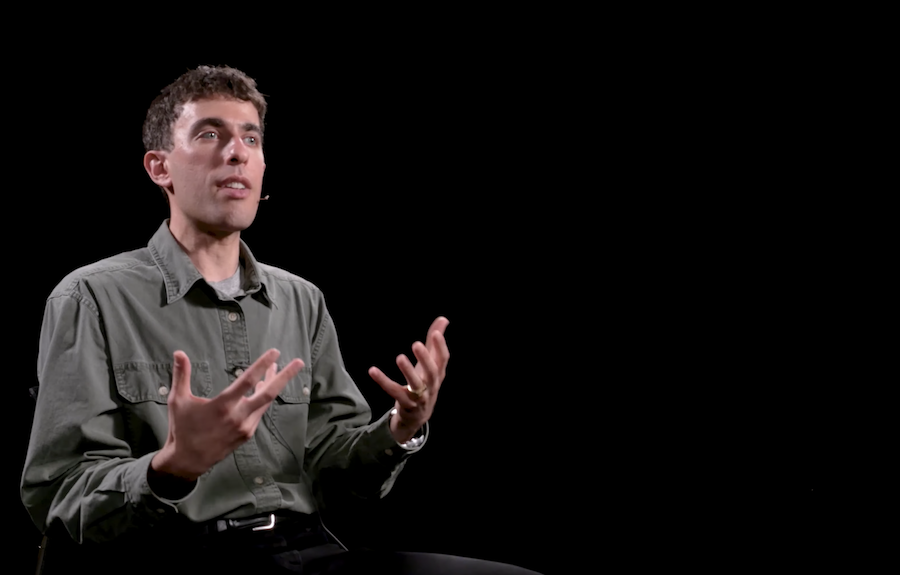 In this episode of
In this episode of 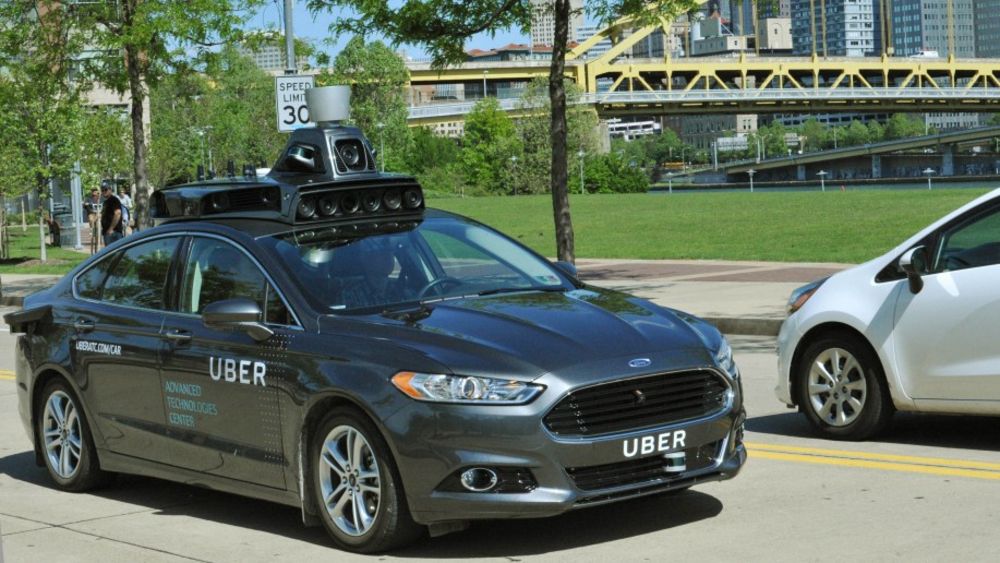
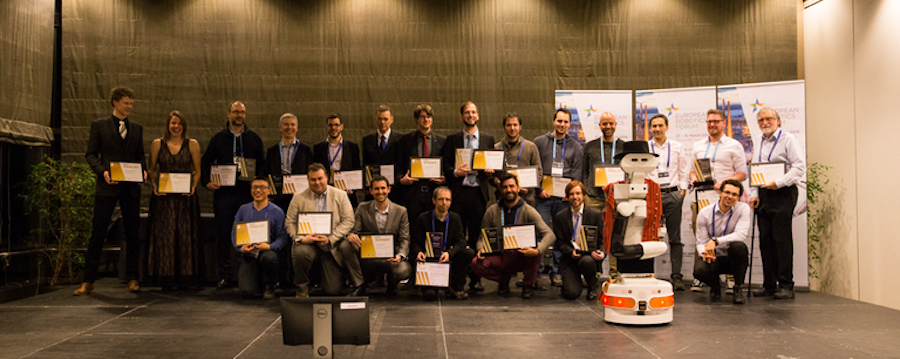



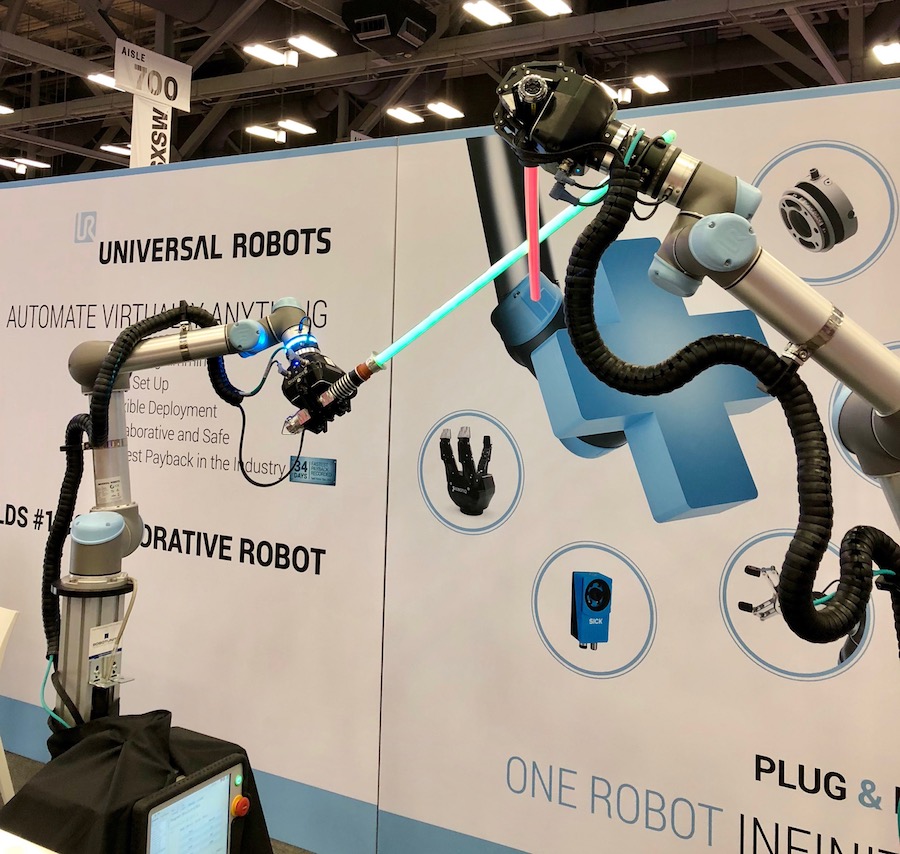





 Tencent, Alibaba, Baidu and JD.com from China are in a global competition with Google/Alphabet, Apple, Facebook, Walmart and Amazon from the USA and SoftBank from Japan. All are agressively searching for talent, intellectual property, market share, logistics and supply chain technology, and presence all around the world.
Tencent, Alibaba, Baidu and JD.com from China are in a global competition with Google/Alphabet, Apple, Facebook, Walmart and Amazon from the USA and SoftBank from Japan. All are agressively searching for talent, intellectual property, market share, logistics and supply chain technology, and presence all around the world.
 Baidu (NASDAQ:BIDU) is China’s primary search source and also provides Internet-related services and products as well as targeted advertising, transaction services and a video platform. Baidu is heavily investing in researching deep learning, computer vision, speech recognition and synthesis, natural language understanding, data mining and knowledge discovery, business intelligence, artificial general intelligence, high performance computing, robotics and autonomous driving (at their new self-driving lab in Silicon Valley).
Baidu (NASDAQ:BIDU) is China’s primary search source and also provides Internet-related services and products as well as targeted advertising, transaction services and a video platform. Baidu is heavily investing in researching deep learning, computer vision, speech recognition and synthesis, natural language understanding, data mining and knowledge discovery, business intelligence, artificial general intelligence, high performance computing, robotics and autonomous driving (at their new self-driving lab in Silicon Valley). Alibaba (NYSE:BABA) is a multi-national China-based e-commerce retailer, payment and technology conglomerate, cloud provider, whose two shopping malls (Tmall and Taobao) have over 1 billion combined active users and are supported by a budding logistics network. Alibaba’s AI-powered platform (which it uses internally for its shopping malls and logistics processing) was recently rolled out in Kuala Lumpur to support smart cities in their digital transformation. It analyzes large data volumes extracted from various sources in an urban environment, through video, image, and speech recognition. The system then uses machine learning to provide insights for city administrators to improve operational efficiencies and monitor security risks.
Alibaba (NYSE:BABA) is a multi-national China-based e-commerce retailer, payment and technology conglomerate, cloud provider, whose two shopping malls (Tmall and Taobao) have over 1 billion combined active users and are supported by a budding logistics network. Alibaba’s AI-powered platform (which it uses internally for its shopping malls and logistics processing) was recently rolled out in Kuala Lumpur to support smart cities in their digital transformation. It analyzes large data volumes extracted from various sources in an urban environment, through video, image, and speech recognition. The system then uses machine learning to provide insights for city administrators to improve operational efficiencies and monitor security risks. Tencent (HKG:0700) is a Chinese provider of Internet and cloud-related services and products, entertainment, music services, AI, real estate and social media including WeChat (which recently hit 1 billion users). More than 35% of WeChat users spend over four hours a day on the service compared to the little more than an hour a day spent on Facebook, Instagram, Snapchat and Twitter combined. Tencent has set up AI labs in Shenzhen and Seattle and is researching voice and image recognition systems and transforming what they’ve learned into apps and algorithms to keep their users informed and attentive.
Tencent (HKG:0700) is a Chinese provider of Internet and cloud-related services and products, entertainment, music services, AI, real estate and social media including WeChat (which recently hit 1 billion users). More than 35% of WeChat users spend over four hours a day on the service compared to the little more than an hour a day spent on Facebook, Instagram, Snapchat and Twitter combined. Tencent has set up AI labs in Shenzhen and Seattle and is researching voice and image recognition systems and transforming what they’ve learned into apps and algorithms to keep their users informed and attentive. JD.Com (NASDAQ:JD) is a Chinese e-commerce competitor with about half the user base of Alibaba yet with very progressive logistics and infrastructure programs. JD (Jingdong) is testing robotic delivery services, operating driverless delivery trucks and building drone delivery ports. JD operates 7 fulfillment centers and 405 warehouses in China. Last month it raised $2.5 billion for its JD Logistics subsidiary to build out and expand their logistics network.
JD.Com (NASDAQ:JD) is a Chinese e-commerce competitor with about half the user base of Alibaba yet with very progressive logistics and infrastructure programs. JD (Jingdong) is testing robotic delivery services, operating driverless delivery trucks and building drone delivery ports. JD operates 7 fulfillment centers and 405 warehouses in China. Last month it raised $2.5 billion for its JD Logistics subsidiary to build out and expand their logistics network. Google/Alphabet (NASDAQ:GOOG) is a Silicon Valley search engine and Internet products company with a stable of forthcoming AI ventures such as Waymo, Verb Surgical and Nest along with consumer products like Google Home, Android phones and Chromebook computers. Google is leveraging their data, processing power, and talent into an array of AI-based apps, processes and products. Their foray into robotics hardware has resulted in much valuable research but all of the units have either been sold off or closed (except for Boston Dynamics and Shaft which are held up from sale by government regulators). Although still a leader in machine learning, Google is finding much competition from their Chinese competitors.
Google/Alphabet (NASDAQ:GOOG) is a Silicon Valley search engine and Internet products company with a stable of forthcoming AI ventures such as Waymo, Verb Surgical and Nest along with consumer products like Google Home, Android phones and Chromebook computers. Google is leveraging their data, processing power, and talent into an array of AI-based apps, processes and products. Their foray into robotics hardware has resulted in much valuable research but all of the units have either been sold off or closed (except for Boston Dynamics and Shaft which are held up from sale by government regulators). Although still a leader in machine learning, Google is finding much competition from their Chinese competitors. Apple (NASDAQ:AAPL) is Apple, a Silicon Valley designer, manufacturer and marketer of phones, media and hardware devices and provider of software, services and digital content. Apple is the world’s largest information technology company by revenue and the world’s second-largest mobile phone manufacturer after Samsung with annual revenue of $229 billion. Building out Siri from the virtual world into the consumer product world with their new Homepod is off to a late start.
Apple (NASDAQ:AAPL) is Apple, a Silicon Valley designer, manufacturer and marketer of phones, media and hardware devices and provider of software, services and digital content. Apple is the world’s largest information technology company by revenue and the world’s second-largest mobile phone manufacturer after Samsung with annual revenue of $229 billion. Building out Siri from the virtual world into the consumer product world with their new Homepod is off to a late start. Facebook (NASDAQ:FB) is also a Silicon Valley-based Internet phenomena with products that include Facebook, Instagram, Messenger, WhatsApp and Oculus. Facebook has over 2.2 billion active users. Their investments in AI appear to be focused on developing a virtual (or physical) assistant. Their acquisition of Ozlo to help Messenger build out a more elaborate virtual assistant for users is an example.
Facebook (NASDAQ:FB) is also a Silicon Valley-based Internet phenomena with products that include Facebook, Instagram, Messenger, WhatsApp and Oculus. Facebook has over 2.2 billion active users. Their investments in AI appear to be focused on developing a virtual (or physical) assistant. Their acquisition of Ozlo to help Messenger build out a more elaborate virtual assistant for users is an example. Walmart (NYSE:WMT) is a global retailer with wholesale facilities, logistics and distribution centers all around the world. Walmart operates over 11,000 stores under 59 names in 28 countries and e-commerce sites in 11 countries. It grosses over $480 billion annually and employs over 2.3 million workers. As Walmart increases its online e-commerce market share while simultaneously changing practices to provide better product transparency (particularly in and faster material handling at its stores and distribution centers, it too is on a talent hunt for roboticists and AI/machine learning people and providers.
Walmart (NYSE:WMT) is a global retailer with wholesale facilities, logistics and distribution centers all around the world. Walmart operates over 11,000 stores under 59 names in 28 countries and e-commerce sites in 11 countries. It grosses over $480 billion annually and employs over 2.3 million workers. As Walmart increases its online e-commerce market share while simultaneously changing practices to provide better product transparency (particularly in and faster material handling at its stores and distribution centers, it too is on a talent hunt for roboticists and AI/machine learning people and providers. Amazon (NASDAQ:AMZN) Amazon is the leading e-commerce seller of products, supply chain services, AI, and cloud services that is copied and competed with around the world. Amazon accounts for ~4% of all retail and ~44% of all e-commerce spending in the US. Amazon’s supply chain and logistics facilities use more than 60,000 robots in its various warehouses and distribution centers, and its cloud services, which not only services Amazon, provides on-demand cloud computing platforms to companies and governments on a subscription basis. Amazon’s Echo/Alexa home assistant has started to include capabilities like a display, camera and alarm clock, security cameras, and even a fashion advisor. It is combining all these different incremental parts to build a smart home robot as they become viable and front-ended by the Alexa voice assistant.
Amazon (NASDAQ:AMZN) Amazon is the leading e-commerce seller of products, supply chain services, AI, and cloud services that is copied and competed with around the world. Amazon accounts for ~4% of all retail and ~44% of all e-commerce spending in the US. Amazon’s supply chain and logistics facilities use more than 60,000 robots in its various warehouses and distribution centers, and its cloud services, which not only services Amazon, provides on-demand cloud computing platforms to companies and governments on a subscription basis. Amazon’s Echo/Alexa home assistant has started to include capabilities like a display, camera and alarm clock, security cameras, and even a fashion advisor. It is combining all these different incremental parts to build a smart home robot as they become viable and front-ended by the Alexa voice assistant.
 Infrastructure
Infrastructure